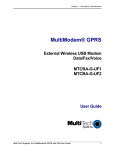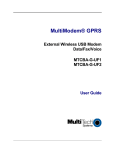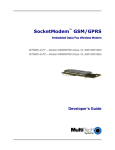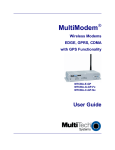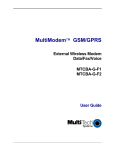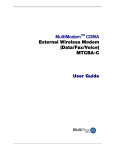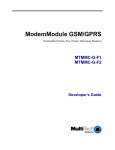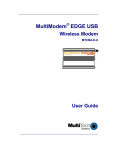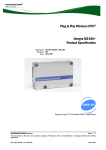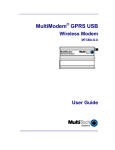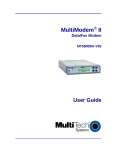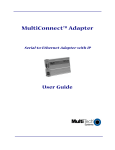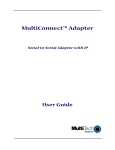Download Multitech CDMA Specifications
Transcript
SocketModem™ CDMA Embedded Data/Fax Wireless Modem MTSMC-C A Global CDMA 2000 1xRTT, 800/1900 MHz Wireless Modem Developer’s Guide SocketModem CDMA Developer’s Guide MTSMC-C – A Global CDMA 2000 1xRTT, 800/1900 MHz Wireless Modem PN S000298B, Version B Copyright This publication may not be reproduced, in whole or in part, without prior expressed written permission from Multi-Tech Systems, Inc. All rights reserved. Copyright © 2003-2004, by Multi-Tech Systems, Inc. Multi-Tech Systems, Inc. makes no representations or a warranty with respect to the contents hereof and specifically disclaims any implied warranties of merchantability or fitness for any particular purpose. Furthermore, Multi-Tech Systems, Inc. reserves the right to revise this publication and to make changes from time to time in the content hereof without obligation of Multi-Tech Systems, Inc. to notify any person or organization of such revisions or changes. Revisions Revision Level A B Date 06/09/03 03/30/04 Description Initial release. Update Features list. Change Operating Temperatures. Add Universal Socket information. Patents This device covered by the following patent: 5,673,268 Trademarks Multi-Tech Trademarks: SocketModem, Multi-Tech, and the Multi-Tech logo. All other products and technologies are the trademarks or registered trademarks of their respective holders. World Headquarters Multi-Tech Systems, Inc. 2205 Woodale Drive Mounds View, Minnesota 55112 Phone: 763-785-3500 or 800-328-9717 Fax: 763-785-9874 Technical Support Country By Email France: [email protected] India: [email protected] U.K.: [email protected] U.S. and Canada: [email protected] Rest of the World: [email protected] Internet Address: http://www.multitech.com By Phone (33) 1-64 61 09 81 91 (124) 6340778 (44) 118 959 7774 (800) 972-2439 (763) 717-5863 Table of Contents Table of Contents CHAPTER 1 – PRODUCT DESCRIPTION AND SPECIFICATIONS .......................................................... 4 PRODUCT DESCRIPTION ............................................................................................................................... 4 APPLICATIONS.............................................................................................................................................. 4 PRODUCT FEATURES .................................................................................................................................... 4 FEATURE DETAILS ........................................................................................................................................ 5 DEVELOPER’S KIT ........................................................................................................................................ 5 TECHNICAL SPECIFICATIONS ......................................................................................................................... 6 RELATED MANUALS ...................................................................................................................................... 6 ADDITIONAL RESOURCES .............................................................................................................................. 6 CHAPTER 2 – MECHANICAL SPECIFICATIONS ...................................................................................... 7 PHYSICAL DIMENSION................................................................................................................................... 7 PIN CONFIGURATIONS .................................................................................................................................. 8 Pin Descriptions...................................................................................................................................... 8 CHAPTER 3 – ELECTRICAL CHARACTERISTICS ................................................................................... 9 I/O ELECTRICAL CHARACTERISTICS .............................................................................................................. 9 POWER CONSUMPTION ................................................................................................................................. 9 HANDLING PRECAUTIONS ............................................................................................................................. 9 CHAPTER 4 – SOCKETMODEM INTERFACES....................................................................................... 10 FLASHING LED INTERFACE ......................................................................................................................... 10 RF INTERFACE ........................................................................................................................................... 10 RF Connector ....................................................................................................................................... 10 CHAPTER 5 – SOCKETMODEM TEST BOARD ...................................................................................... 11 SERIAL TEST/DEMO BOARD COMPONENTS .................................................................................................. 11 SERIAL TEST/DEMO BOARD BLOCK DIAGRAM .............................................................................................. 12 CHAPTER 6 – APPLICATION CONSIDERATIONS ................................................................................. 13 GENERAL GUIDELINES FOR THE USE OF THE SOCKETMODEM ....................................................................... 13 Hardware and RF ................................................................................................................................. 13 The Antenna ......................................................................................................................................... 13 Soldering and Cleaning the SocketModem .......................................................................................... 13 FIRMWARE UPGRADE ................................................................................................................................. 13 INITIAL CONFIGURATION USING MOBILE PHONETOOLS ................................................................................. 13 APPENDIX A – SAFETY ............................................................................................................................ 14 SAFETY PRECAUTIONS ............................................................................................................................... 14 RF Safety.............................................................................................................................................. 14 General Safety...................................................................................................................................... 15 General Safety Standards .................................................................................................................... 16 RF Exposures ....................................................................................................................................... 16 Instructions to OEMs ............................................................................................................................ 16 APPENDIX B – SOURCES FOR PERIPHERAL DEVICES ...................................................................... 17 CDMA ANTENNA ....................................................................................................................................... 17 MMCX PLUG ............................................................................................................................................. 17 ANTENNA CABLE ........................................................................................................................................ 17 APPENDIX C – AT COMMANDS............................................................................................................... 18 APPENDIX D – ACRONYMS AND ABBREVIATIONS ............................................................................. 19 APPENDIX E – WARRANTY AND REPAIRS ........................................................................................... 20 Multi-Tech Warranty Statement............................................................................................................ 20 Repair Procedures for U.S. and Canadian Customers ........................................................................ 20 Repair Procedures for International Customers (Outside U.S.A. and Canada)................................... 21 Repair Procedures for International Distributors .................................................................................. 21 INDEX ......................................................................................................................................................... 22 Multi-Tech Systems, Inc. SocketModem CDMA Developer’s Guide 3 Chapter 1 – Product Description and Specifications Chapter 1 – Product Description and Specifications Product Description The Multi-Tech SocketModem CDMA is a complete, ready-to-integrate, embedded wireless modem. Designed for global use, it offers standards-based multi-band CDMA200 1x performance. The SocketModem CDMA is based on industry-standard open interfaces and utilizes Multi-Tech’s universal socket design. Applications The CDMA SocketModem is targeted at applications that periodically need to send or receive data over a wireless network. It is an ideal solution for: • • • • • • • • • • • Appliances ATM terminals Automotive Data collection Gas pumps Industrial and medical remote monitoring systems Remote diagnostics Remote metering Security systems Vending/gaming machines Other devices requiring wireless connectivity Product Features • • • • • • • • • • • • • • • • • CDMA200 1xRTT CDMA IS-95-A, IS-95B Class 2.0 Group 3 FAX Dual-band 800/1900 CDMA Short Message Services features including text SMS mobile originated, SMS mobile terminated, cell broadcast, Over the Air Activation (OTA), OTASP, OTAPA 14.4K circuit switched data MMCX antenna connector Serial interface supports DTE speeds to 230K AT command compatible* Phone book management Personal Information Management (PIM) Fixed dialing number Real time clock Alarm management Packet data up to 153K bps forward and reverse Circuit-switched data up to 14.4K bps Universal socket connectivity *AT Commands - AT commands for this product are published in a separate document available on the Developer’s Kit product CD or from Multi-Tech. For a copy of this document, contact OEM Sales at [email protected] or call (800) 972-2439. Multi-Tech Systems, Inc. SocketModem CDMA Developer’s Guide 4 Chapter 1 – Product Description and Specifications Feature Details Integration Reduces Space, Power, and Cost. The SocketModem CDMA integrates the controller, RF transceiver, and antenna interface in one module. This integration requires low power and low real estate, and it provides an overall reduction in costs. Reduces Development Time. The SocketModem CDMA can make your existing and next generation device, machine, or system communication-ready without requiring significant hardware changes to its design. This complete, ready-to-integrate wireless SocketModem allows you to enhance your product while you focus on developing its core features. Short Message Services. The SocketModem CDMA offers SMS features such as mobile originated, mobile terminated, cell broadcast, Over the Air Activation (OTA), OTASP, and OTAPA. Management Features. The SocketModem CDMA provides advanced management features that include: phone book management, fixed dialing number, real time clock, and alarm management. Industry-standard Modem Commands. The SocketModem CDMA provides industry-standard ATstyle commands for ease of integration into your existing software application. SocketModem Pin-Out. The SocketModem CDMA interfaces easily with existing products through a standard serial communication channel. The complete on-board RF transceiver interfaces with an antenna for direct connection to wireless SMS, circuit-switched dial-up, or packet data networks. The SocketModem also includes an onboard LED to display network status. The SocketModem is a Data Terminal Equipment (DTE) device with serial asynchronous protocol support. The serial DTE channel is capable of transfer speeds to 230K bps and can be interfaced directly to a UART or microcontroller. Packet-switched Data. The SocketModem CDMA supports CDMA 2000 1xRTT packet-switched cellular data. This enables mobile Internet functionality by allowing interworking between the existing Internet and the cellular network at speeds up to 153K bps (forward and reverse). Any service that is used over the fixed Internet today - File Transfer Protocol (FTP), web browsing, chat, e-mail, telnet is available over the cellular network as well. Circuit-switched Data (CSD). The SocketModem CDMA also supports CDMA IS-95A and IS-95B circuit-switched cellular data connections. Circuit-switched data connections support speeds up to 14.4K bps as well as Class 2.0 Group 3 fax. CSD cellular wireless connections are ideal for applications that require a quick wireless replacement of an existing point-to-point analog dial-up connection. They integrate seamlessly with your current application requiring little infrastructure change. Universal Socket Connectivity. The SocketModem's flexible comm-port architecture provides dialup, wireless, or Ethernet socket connectivity with interchangeable modules. This means you can utilize one system design and populate it with your communication module of choice. In addition, you are assured a seamless migration to future technologies. Developer’s Kit The SocketModem CDMA Developer’s Kit allows you to plug in the SocketModem and use it for testing, programming, and evaluation. The kit includes: • one development board with RS-232 DB-25 connector • universal power supply • antenna • RS-232 cable Multi-Tech Systems, Inc. SocketModem CDMA Developer’s Guide 5 Chapter 1 – Product Description and Specifications Technical Specifications The SocketModem CDMA meets the following specifications: Fax Compatibility Weight Dimensions Power Requirements Operating Environment Storage Temperature Certifications Cleaning CDMA Class 2.0 Group 3 Fax 1.2 oz (34 g) 3.1” w x 1.4” h x 0.5” d (8.0 cm x 3.5 cm x 1.2 cm) 5 VDC; 400mA Typical, 700mA Maximum -30° to +70° C -30° to +85° C EMC: FCC Part 2, 15, 22, 24, EN 55022 & EN55024 Safety: UL 60950, EN 60950 No cleaning/washing due to the manufacturing process used to produce this product Related Manuals AT commands for this product are published in a separate document available on the Developer’s Kit system CD or from Multi-Tech. Multi-Tech manuals and other resources are available on the MultiTech Web page at http://www.multitech.com. Additional Resources European Telecommunications Standards Institute (ETSI) - Contact the ETSI at: 650, route des Lucioles 06921 Sophia-Antipolis Cedex France Tel: +33 (0)4 92 94 42 00 Fax: +33 (0)4 93 65 47 16 http://www.etsi.org Global Engineering Documents manages a collection of more than one million documents from over 460 organizations worldwide: http://global.ihs.com Phone: 800-854-7179 Fax: 303-792-2192 The ITU is the leading publisher of telecommunication technology, regulatory and standards information, with over 4,000 titles in printed form, on CD-ROM and Online at http://www.itu.int/publications/ Multi-Tech Systems, Inc. SocketModem CDMA Developer’s Guide 6 Chapter 2 – Mechanical Specifications Chapter 2 – Mechanical Specifications Physical Dimension SocketModem CDMA Mechanical Drawing Multi-Tech Systems, Inc. SocketModem CDMA Developer’s Guide 7 Chapter 2 – Mechanical Specifications Pin Configurations The SocketModem CDMA uses a 13-pin interface. SocketModem Pins - Top View Pin Descriptions Pin # 24 26, 41, 63 33 34 35 36 37 38 39 40 61 Signal I/O Description Name Type -RESET I/O Reset. This signal is used to force a reset procedure by providing low level during at least 500µs. This signal is considered an emergency reset only. A reset procedure is already driven by an internal hardware during the power-up sequence. This signal can also be used to provide a reset to an external device. It then acts as an output. If no external reset is necessary, this input can be left open. If used (emergency reset), it has to be driven by an open collector or an open drain. GND Ground –RTS I Request to Send. The –RTS signal is used for hardware flow control. –RXD O Received Data. The modem uses the RXD line to send received data to the DTE and to send modem responses to the DTE. –TXD I Transmitted Data. The DTE uses the –TXD line to send data to the modem or to transmit commands to the modem. –RI O Ring Indicate. –RI output ON (low) indicates the presence of a ring signal ON segment. –DSR O Data Set Ready. –DSR indicates modem status to the DTE. –DSR OFF (high) indicates that the DTE is to disregard all signals appearing on the interchange circuits except Ring Indicator (–RI). It reflects the status of the local data set and does not indicate an actual link with any remote data equipment. –CTS O Clear To Send. –CTS is controlled by the modem to indicate whether or not the modem is ready to transmit data. –CTS ON, indicates to the DTE that signals presented on TXD will be transmitted. –CTS OFF indicates to the DTE that it should not transfer data across the interface on TXD. –DCD O Data Carrier Detect. –DCD output is ON (low) when a data connection is established. –DTR I Data Terminal Ready (Active Low). The –DTR input is turned ON (low) by the DTE when the DTE is ready to transmit or receive data. –DTR ON prepares the modem to be connected, and, once connected, maintains the connection. –DTR OFF places the modem in the disconnect state. VCC PWR +5V Multi-Tech Systems, Inc. SocketModem CDMA Developer’s Guide 8 Chapter 3 – Electrical Characteristics Chapter 3 – Electrical Characteristics Electrical characteristics for the 5V Serial SocketModem are presented in this chapter. I/O Electrical Characteristics 5 Vdc Characteristics (TA = -20° C to 55° C; VDD = 5 V ± 0.25 V) VDDMAX = 5.25 V Digital Inputs Input High Input Low –DTR (40), –TXD (35), –RTS (33), –RESET (24) Min 3.675 V Max 1.4 V Digital Outputs Output High Output Low Current –DCD (39), –CTS (38), –DSR (37), –RI (36), –RXD (34) Min. 4 V Max 0.4 V Drive: 2 ma Digital Input Capacitance 5 PF Power Consumption Operating Mode CDMA RXTX Full Power CMA RXTX Average Power CDMA Standby Band Cellular PCS Cellular PCS Cellular Average (mA) 615 770 340 445 20 PCS 20 Handling Precautions All devices must be handled with certain precautions to avoid damage due to the accumulation of static charge. Although input protection circuitry has been incorporated into the devices to minimize the effect of this static buildup, proper precautions should be taken to avoid exposure to electrostatic discharge during handling and mounting. Multi-Tech Systems, Inc. SocketModem CDMA Developer’s Guide 9 Chapter 4 – SocketModem Interfaces Chapter 4 – SocketModem Interfaces This chapter describes the SocketModem interfaces. • Flashing LED Interface • RF Interface Flashing LED Interface The flashing LED signal is used to indicate the working mode of the SocketModem. LED and SocketModem Status Signal OFF ON SocketModem Status Download mode or switched OFF> Continuously lit Switched ON (not registered on the network) Flashing Switched ON (registered on the network) RF Interface The impedance is 50 Ohms nominal. RF Connector The RF connector is MMCX standard type. An antenna can be directly connected through the mating connector or using a small adapter. Multi-Tech Systems, Inc. SocketModem CDMA Developer’s Guide 10 Chapter 5 – SocketModem Test Board Chapter 5 – SocketModem Test Board Serial Test/Demo Board Components Multi-Tech Systems, Inc. SocketModem CDMA Developer’s Guide 11 Chapter 5 – SocketModem Test Board Serial Test/Demo Board Block Diagram Block Diagram for the SocketModem CDMA Multi-Tech Systems, Inc. SocketModem CDMA Developer’s Guide 12 Chapter 6 – Application Considerations Chapter 6 – Application Considerations General Guidelines for the Use of the SocketModem Hardware and RF • Ground plane: Multi-Tech recommends having a common ground plane for analog, digital, and RF grounds. • ESD protection on serial link, … • Possible spurious emission radiated by the application to the RF receiver in the receiver band. The Antenna The antenna sub-system and integration in the application is a major issue. It is a major issue in the choice of the antenna cable (type, length, performances, thermal resistance, etc.) These elements could affect CDMA performances such as sensitivity and emitted power. The antenna should be isolated as much as possible from the digital circuitry including the interface signals. Multi-Tech recommends shielding the terminal. On terminals including the antenna, a poor shielding could dramatically affect the sensitivity of the terminal. Subsequently, the power emitted through the antenna could affect the application. Soldering and Cleaning the SocketModem The pins of the SocketModem may be hand soldered or wave soldered. If wave soldered, the temperature on the top of the SocketModem must not exceed 100° C. There should be no solvent or water washing of the SocketModem. Do not use a hot air gun on the SocketModem. Firmware Upgrade The SocketModem firmware is stored in flash memory, and it can easily be upgraded. Contact the factory for details. Initial Configuration Using Mobile PhoneTools For initial configuration of your wireless device, Multi-Tech offers a Windows-based mobile PhoneTools application. To load Mobile PhoneTools, click the Mobile PhoneTools icon on the product CD and follow the onscreen prompts. Multi-Tech Systems, Inc. SocketModem CDMA Developer’s Guide 13 Appendix A – Safety Appendix A – Safety Safety Precautions IMPORTANT! FOR THE EFFICIENT AND SAFE OPERATION OF YOUR CDMA INTEGRATED MODEM READ THIS INFORMATION BEFORE USE. RF Safety General Your SocketModem is based on the CDMA standard for cellular technology. Your modem is actually a low power radio transmitter and receiver. It sends out and receives radio frequency energy. When you use your SocketModem integrated modem, the cellular system, which handles your calls controls both the radio frequency and the power level of your cellular modem. Exposure to RF Energy There has been some public concern about possible health effects of using CDMA modems. Although research on health effects from RF energy has focused on the current RF technology for many years, scientists have begun research regarding newer radio technologies, such as CDMA. After existing research had been reviewed, and after compliance to all applicable safety standards had been tested, it has been concluded that the product was fitted for use. If you are concerned about exposure to RF energy there are things you can do to minimize exposure. Obviously, limiting the duration of your calls will reduce your exposure to RF energy. In addition, you can reduce RF exposure by operating your cellular modem efficiently by following the below guidelines. Efficient Modem Operation For your modem to operate at the lowest power level, consistent with satisfactory call quality: • If your modem has an extendible antenna, extend it fully. Some models allow you to place a call with the antenna retracted. However your modem operates more efficiently with the antenna fully extended. • Do not hold the antenna when the modem is IN USE. Holding the antenna affects call quality and may cause the modem to operate at a higher power level than needed. Antenna Care and Replacement Do not use the modem with a damaged antenna. If a damaged antenna comes into contact with the skin, a minor burn may result. Replace a damaged antenna immediately. Consult your manual to see if you may change the antenna yourself. If so, use only a manufacturer-approved antenna. Otherwise, have your antenna repaired by a qualified technician. Use only the supplied or approved antenna. Unauthorized antennas, modifications, or attachments could damage the modem and may contravene local RF emission regulations or invalidate type approval. Multi-Tech Systems, Inc. SocketModem CDMA Developer’s Guide 14 Appendix A – Safety General Safety Driving Check the laws and the regulations regarding the use of cellular devices in the area where you have to drive as you must comply with these laws and regulations. When using your modem while driving, please give full attention to driving. Pull off the road and park before making or answering a call if driving conditions so require. Electronic Devices Most electronic equipment, for example in hospitals and motor vehicles, is shielded from RF energy. However, RF energy may affect some improperly shielded electronic equipment. Vehicle Electronic Equipment Check your vehicle manufacturer representative to determine if any on-board electronic equipment is adequately shielded from RF energy. Medical Electronic Equipment Consult the manufacturer of any personal medical devices (such as pacemakers, hearing aids, etc.) to determine if they are adequately shielded from external RF energy. Turn your modem OFF in health care facilities when any regulations posted in the area instruct you to do so. Hospitals or health care facilities may be using RF monitoring equipment. Aircraft Turn your modem OFF before boarding any aircraft. • Use it on the ground only with crew permission. • Do not use it in the air. To prevent possible interference with aircraft systems, Federal Aviation Administration (FAA) regulations require you to have permission from a crew member to use your modem while the aircraft is on the ground. To prevent interference with cellular systems, local RF regulations prohibit using your modem while airborne. Children Do not allow children to play with your modem. It is not a toy. Children could hurt themselves or others (by poking themselves or others in the eye with the antenna, for example). Children could damage the modem or make calls that increase your modem bills. Blasting Areas To avoid interfering with blasting operations, turn your unit OFF when in a “blasting area” or in areas posted “turn off two-way radio”. Construction crews often use remote control RF devices to set off explosives. Potentially Explosive Atmospheres Turn your modem OFF when in any area with a potentially explosive atmosphere. It is rare, but your modem or its accessories could generate sparks. Sparks in such areas could cause an explosion or fire resulting in bodily injuries or even death. Areas with a potentially explosive atmosphere are often, but not always, clearly marked. They include fueling areas such as gas stations; below deck on boats; fuel or chemical transfer or storage facilities; and areas where the air contains chemicals or particles, such as grain, dust, or metal powders. Do not transport or store flammable gas, liquid, or explosives, in the compartment of your vehicle, which contains your modem or accessories. Before using your modem in a vehicle powered by liquefied petroleum gas (such as propane or butane) ensure that the vehicle complies with the relevant fire and safety regulations of the country in which the vehicle is to be used. Multi-Tech Systems, Inc. SocketModem CDMA Developer’s Guide 15 Appendix A – Safety General Safety Standards THIS WIRELESS SOCKETMODEM COMPLIES WITH ALL APPLICABLE RF SAFETY STANDARDS. This cellular modem meets the standards and recommendations for the protection of public exposure to RF electromagnetic energy that have been established by governmental bodies and other qualified organizations, such as the following: • Directives of the European Community, • Directorate General V in Matters of Radio Frequency Electromagnetic Energy RF Exposures Pursuant to 47 CFR § 24.52 of the FCC Rules and Regulations, personal communications services (PCS) equipment is subject to the radio frequency radiation exposure requirements specified in § 1.1307(b), § 2.1091 and § 2.1093 as appropriate. The Multi-Tech SocketModem is a CDMA (PCS 800/1900) terminal which operates in the US licensed PCS frequency spectrum. The device transmits over the 1850-1910 MHz or 824-849 MHz bands and receives over the 1930-1990 MHz or 869-894 MHz bands. Multi-Tech Systems, Inc. certifies that it has determined that the Modem complies with the RF hazard requirements applicable to broadband PCS equipment operating under the authority of 47 CFR Part 24, Subpart E of the FCC Rules and Regulations. This determination is dependent upon installation, operation, and use of the equipment in accordance with all instructions provided. The modem is designed for and intended to be used in fixed and mobile applications. "Fixed" means that the device is physically secured at one location and is not able to be easily moved to another location. "Mobile" means that the device is designed to be used in other than fixed locations and generally in such a way that a separation distance of at least 20 cm is normally maintained between the transmitter's antenna and the body of the user or nearby persons. The Modem is not designed for or intended to be used in portable applications (within 20 cm of the body of the user) and such uses are strictly prohibited. To ensure that the unit complies with current FCC regulations limiting both maximum RF output power and human exposure to radio frequency radiation, a separation distance of at least 20 cm must be maintained between the unit's antenna and the body of the user and any nearby persons at all times and in all applications and uses. Additionally, in mobile applications, maximum antenna gain must not exceed 3 dBi to comply with Section 24.232(b) and is limited to 7 dBi for fixed applications. Finally, the tune-up procedure for the modem ensures that the maximum RF output power of the device does not exceed 30.0 dBm within the variations that can be expected due to quantity production and testing on a statistical basis. Instructions to OEMs The Multi-Tech product manual includes specific warnings and cautions in order to ensure that OEMs are aware of their responsibilities, with regards to RF exposure compliance, for products into which the modem is integrated. With this guidance, the OEM will be able to incorporate into their documentation the necessary operating conditions and warnings. OEMs need to provide a manual with the ‘’final’’ product that clearly states the operating requirements and conditions and that these must be observed to ensure compliance with current FCC RF exposure requirements / MPE limits (see the “RF Exposures” section above). This will enable the OEM to generate (and provide the end-user with) the appropriate operating instructions, warnings and cautions, and/or markings for their product. Multi-Tech Systems, Inc. SocketModem CDMA Developer’s Guide 16 Appendix B – Sources for Peripheral Devices Appendix B – Sources for Peripheral Devices CDMA Antenna The integrated modem antenna connector is a MMCX connector. The MMCX connector incorporates a 'Snap On' latching action in order to make the connection easier with an excellent RF performance. An additional advantage is its small physical size, which is 50% of the standard MCX connector. This type of connector is suitable for the standard ranges of flexible and semi-rigid cables. The characteristic impedance of the MMCX coaxial connector is 50 ohm. The antenna manufacturer must guarantee that the antenna will be working according to the radio characteristics presented in the table below. Radio Characteristics Frequency RX Frequency TX Impedance VSWR Typical Radiated Gain CDMA 800 869 to 894 MHz 824 to 849 MHz CDMA 1900 1930 to 1990 MHz 1850 to 1910 MHz 50 ohms <1.5 0 dBi in at least one direction Antenna An antenna with matting connector can be ordered, for example, from: IMS Connectors Systems GMBH http://www.imscs.com/ MMCX Plug The SocketModem requires an MMCX plug to connect to an antenna. MMCX Connector Example (right angle type) MMCX / SMA Adapter A small MMCX / SMA adapter can be ordered, for example, from: Amphenol http://www.amphenol.com Order No: 908-31100 Antenna Cable An optional 6” antenna cable can be ordered from Multi-Tech Systems, Inc. 6-Inch Antenna Cable – SMA Jack to MMCX Plug Antenna Cable – SMA Jack to MMCX Plug Multi-Tech Systems, Inc. http://www.multitech.com/ Order No: 45009630 Multi-Tech Systems, Inc. SocketModem CDMA Developer’s Guide 17 Appendix C – AT Commands Appendix C – AT Commands AT Commands for the CDMA wireless modem are published in a separate Reference Guide included on the product CD and the Multi-Tech Web site. Multi-Tech Systems, Inc. SocketModem CDMA Developer’s Guide 18 Appendix D – Acronyms and Abbreviations Appendix D – Acronyms and Abbreviations ADC – Analog Digital Converter ASIC – Application Specific Integrated Circuit BCCH – Broadcast Control Channel CLK – Clock CTS – Clear To send dB – decibel DCD – Data Carrier Detect DCE – Data Circuit Terminating Equipment DSR – Data Set Ready DTE – Data Terminal Equipment DTR – Data Terminated Ready EFR – Enhanced Full Rate ECDMA – Extended CDMA EMC – Electromagnetic Conformity EN – Enable ETSI – European Telecommunications Standards Institute FAC – Final Assembly Code FR – Full-Rate FTA – Full Type Approval GND – Ground GPIO – General Purpose Input Output CDMA – Global System for Mobile Communication HR – Half-Rate IMEI – International Mobile Equipment Identity MO – Mobile Originated MT – Mobile Terminated OEM – Original Equipment Manufacturer PDA – Personal Digital Assistant PCB – Printed Circuit Board PRES – Presence RF – Radio Frequency RI – Ring Indicator RTS – Request To Send SMD – Surface Mounted Design SMS – Short Message Service TAC – Type Approval Code TDMA – Time Code Multiple Access TE – Terminal Equipment VSWR – Voltage Standing Wave Ratio WAP – Wireless Application Protocol Multi-Tech Systems, Inc. SocketModem CDMA Developer’s Guide 19 Appendix E – Warranty and Repairs Appendix E – Warranty and Repairs Multi-Tech Warranty Statement Multi-Tech Systems, Inc., (hereafter “MTS”) warrants that its products will be free from defects in material or workmanship for a period of two, five, or ten years (depending on model) from date of purchase, or if proof of purchase is not provided, two, five, or ten years (depending on model) from date of shipment. MTS MAKES NO OTHER WARRANTY, EXPRESS OR IMPLIED, AND ALL IMPLIED WARRANTIES OF MERCHANTABILITY AND FITNESS FOR A PARTICULAR PURPOSE ARE HEREBY DISCLAIMED. This warranty does not apply to any products which have been damaged by lightning storms, water, or power surges or which have been neglected, altered, abused, used for a purpose other than the one for which they were manufactured, repaired by Customer or any party without MTS’s written authorization, or used in any manner inconsistent with MTS’s instructions. MTS’s entire obligation under this warranty shall be limited (at MTS’s option) to repair or replacement of any products which prove to be defective within the warranty period or, at MTS’s option, issuance of a refund of the purchase price. Defective products must be returned by Customer to MTS’s factory — transportation prepaid. MTS WILL NOT BE LIABLE FOR CONSEQUENTIAL DAMAGES, AND UNDER NO CIRCUMSTANCES WILL ITS LIABILITY EXCEED THE PRICE FOR DEFECTIVE PRODUCTS. Repair Procedures for U.S. and Canadian Customers In the event that service is required, products may be shipped, freight prepaid, to our Mounds View, Minnesota factory: Multi-Tech Systems, Inc. 2205 Woodale Drive Mounds View, MN 55112 Attn: Repairs, Serial # ____________ A Returned Materials Authorization (RMA) is not required. Return shipping charges (surface) will be paid by MTS to destinations in U.S. and Canada. Please include, inside the shipping box, a description of the problem, a return shipping address (must have street address, not P.O. Box), your telephone number, and if the product is out of warranty, a check or purchase order for repair charges. For out of warranty repair charges, go to www.multitech.com/DOCUMENTS/Company/warranty/ Extended two-year overnight replacement service agreements are available for selected products. Please call MTS customer service at (888) 288-5470 or visit our web site at www.multitech.com/PARTNERS/Programs/orc/ for details on rates and coverage’s. Please direct your questions regarding technical matters, product configuration, verification that the product is defective, etc., to our Technical Support department at (800) 972-2439 or email [email protected]. Please direct your questions regarding repair expediting, receiving, shipping, billing, etc., to our Repair Accounting department at (800) 328-9717 or (763) 717-5631, or email [email protected]. Repairs for damages caused by lightning storms, water, power surges, incorrect installation, physical abuse, or usercaused damages are billed on a time-plus-materials basis. Multi-Tech Systems, Inc. SocketModem CDMA Developer’s Guide 20 Appendix E – Warranty and Repairs Repair Procedures for International Customers (Outside U.S.A. and Canada) Your original point of purchase Reseller may offer the quickest and most economical repair option for your Multi-Tech product. You may also contact any Multi-Tech sales office for information about the nearest distributor or other repair service for your Multi-Tech product. The Multi-Tech sales office directory is available at www.multitech.com/PARTNERS/Channels/offices/ In the event that factory service is required, products may be shipped, freight prepaid to our Mounds View, Minnesota factory. Recommended international shipment methods are via Federal Express, UPS or DHL courier services, or by airmail parcel post; shipments made by any other method will be refused. A Returned Materials Authorization (RMA) is required for products shipped from outside the U.S.A. and Canada. Please contact us for return authorization and shipping instructions on any International shipments to the U.S.A. Please include, inside the shipping box, a description of the problem, a return shipping address (must have street address, not P.O. Box), your telephone number, and if the product is out of warranty, a check drawn on a U.S. bank or your company’s purchase order for repair charges. Repaired units shall be shipped freight collect, unless other arrangements are made in advance. Please direct your questions regarding technical matters, product configuration, verification that the product is defective, etc., to our Technical Support department nearest you or email [email protected]. When calling the U.S., please direct your questions regarding repair expediting, receiving, shipping, billing, etc., to our Repair Accounting department at +(763) 717-5631 in the U.S.A., or email [email protected]. Repairs for damages caused by lightning storms, water, power surges, incorrect installation, physical abuse, or usercaused damages are billed on a time-plus-materials basis. Repair Procedures for International Distributors International distributors should contact their MTS International sales representative for information about the repairs for their Multi-Tech product. Please direct your questions regarding technical matters, product configuration, verification that the product is defective, etc., to our International Technical Support department at +(763)717-5863. When calling the U.S., please direct your questions regarding repair expediting, receiving, shipping, billing, etc., to our Repair Accounting department at +(763) 717-5631 in the U.S.A. or email [email protected]. Repairs for damages caused by lightning storms, water, power surges, incorrect installation, physical abuse, or usercaused damages are billed on a time-plus-materials basis. Multi-Tech Systems, Inc. SocketModem CDMA Developer’s Guide 21 Index Index ADC..................................................................19 aircraft and safety.............................................15 antenna ......................................................10, 13 antenna cable.............................................13, 17 antenna care and replacement ........................14 applications ........................................................4 ASIC .................................................................19 AT commands documentation .......................4, 6 BCCH ...............................................................19 blasting areas and safety .................................15 Block Diagram..................................................12 CDMA...............................................................19 CDMA antenna.................................................17 children and safety ...........................................15 Cleaning Safety Standards ..............................13 CTS ..................................................................19 dB .....................................................................19 DCD..................................................................19 DCE..................................................................19 Developer’s Kit ...................................................5 driving safety ....................................................15 DSR..................................................................19 DTE ..................................................................19 DTR ..................................................................19 EFR ..................................................................19 Electrical characteristics.....................................9 electronic devices and safety ...........................15 EMC .................................................................19 EN ....................................................................19 ESD protection .................................................13 ETSI .................................................................19 explosive atmospheres and safety...................15 Exposure to RF Energy....................................14 FAC ..................................................................19 features ..............................................................4 flashing LED interface ......................................10 FR.....................................................................19 FTA...................................................................19 gain...................................................................16 GND .................................................................19 GPIO ................................................................19 Handling Precautions .........................................9 Hardware and RF.............................................13 HR ....................................................................19 IMEI.................................................................. 19 initial configuration ........................................... 13 Instructions to OEMs ....................................... 16 interfaces ......................................................... 10 Mechanical Drawing........................................... 7 medical electronic equipment and safety ........ 15 MMCX (Miniature Micro Connector) .......... 10, 17 MO ................................................................... 19 MT .................................................................... 19 OEM................................................................. 19 operating conditions......................................... 16 PCB.................................................................. 19 PCS.................................................................. 16 PDA.................................................................. 19 PhoneTools...................................................... 13 Pin Descriptions ................................................. 8 Power Consumption........................................... 9 PRES ............................................................... 19 radio ................................................................. 14 Repairs............................................................. 20 RF .................................................................... 19 RF connector ................................................... 10 RF Exposures .................................................. 16 RF Interface ..................................................... 10 RF safety.......................................................... 14 RI ..................................................................... 19 RTS.................................................................. 19 safety ............................................................... 14 Safety Standards ............................................. 16 SMD ................................................................. 19 SMS ................................................................. 19 Soldering Safety Standards ............................. 13 Specifications technical ......................................................... 6 TAC.................................................................. 19 TDMA............................................................... 19 TE .................................................................... 19 Technical specifications ..................................... 6 vehicle electronic equipment and safety.......... 15 VSWR .............................................................. 19 WAP................................................................. 19 Warranty .......................................................... 20 Multi-Tech Systems, Inc. SocketModem CDMA Developer’s Guide 22






















